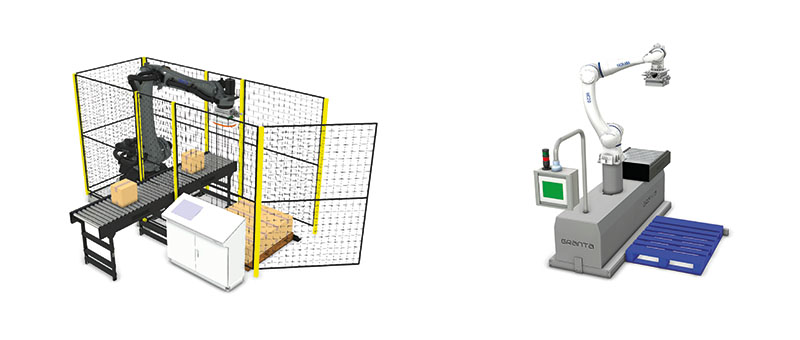One of the core logistical challenges in food production and packaging is how to optimise space. Along with an increasing demand for efficiency, safety, and quality in production processes. Floor space is often at a premium in food manufacturing environments, where every square foot matters. This makes the implementation of automation technologies like palletisers crucial, as they not only improve productivity but also streamline space utilisation. However, if you have space for a person to walk around a pallet that is being stacked, then you have space for a palletiser.
Space Challenges in the Food Industry
The food production industry often operates in environments that require meticulous attention to cleanliness, safety, and efficiency. Given these constraints, floor space becomes a highly valuable asset. Here are some of the primary space-related challenges faced by food manufacturers:
- Regulatory Compliance: Many food production environments are subject to strict health and safety regulations, including the need for clear separation between production, packaging, and storage areas. This limits how machinery and equipment can be placed, leaving minimal room for palletisers and other automation systems.
- Expansion Constraints: As demand for food products grows, manufacturers are often forced to expand production capacity. However, physical expansion isn’t always possible due to existing building layouts or high costs of construction. In such cases, optimising the use of existing space is critical.
- Multiple Product Lines: Many food manufacturers need to handle multiple product lines in one facility, leading to a more complex layout. This can increase the pressure to streamline packaging and palletising processes, as machines for different lines compete for limited space.
- Workplace Safety: The movement of pallets, forklifts, and workers in a cramped environment increases the risk of accidents. Effective space utilisation, therefore, contributes to a safer working environment by reducing congestion.
- Maximising Throughput: The faster products can be palletized, the more efficiently they can be moved to storage or shipping. However, larger palletisers or inefficient layouts can limit production speed due to their footprint, hindering the overall flow of the production line.
How Compact Palletisers Solve Space Challenges
Compact palletisers, such as the one designed by Granta Automation, offer several advantages to food manufacturers who need to optimise space without sacrificing efficiency. Here’s how they can address the industry’s space constraints:
1. Minimal Footprint
Compact palletisers are specifically designed with a small footprint, making them ideal for food production facilities where floor space is limited. Requiring less room than traditional palletising systems, allowing manufacturers to fit the machine into tight spaces, freeing up more space for other critical equipment.
2. Flexible Layout Options
Many palletisers offer flexibility in terms of layout. They can be easily integrated into existing production lines without major modifications, reducing downtime and disruption to existing workflows. This flexibility is essential for manufacturers who need to optimise their layout based on available space.
3. Fast Setup and Installation
Unlike larger palletising machines that require extensive installation time and space modification, compact palletisers like the Granta model are quick and easy to set up. This saves manufacturers both time and money, allowing them to begin operations with minimal disruption.
4. Customisable for Various Product Sizes
Despite their small size, compact palletisers can handle a wide range of product dimensions and weights. For example, the Granta compact palletiser can work with bags, boxes, cartons, trays, and many other types of packaging commonly used in the food industry. This versatility helps food manufacturers make the most of their space by accommodating various packaging requirements without the need for multiple machines.
5. High Efficiency in a Small Space
Compact palletisers are capable of delivering high throughput despite their smaller size. This ensures that manufacturers don’t have to compromise between space-saving and operational efficiency.
6. Improved Safety
Automating the palletising process with a compact machine reduces the need for manual labour in tight spaces, improving worker safety. Fewer employees are needed to manually stack and move products, reducing the chances of accidents in congested areas.
Additional Benefits of Compact Palletisers
In addition to solving space issues, compact palletisers bring several other benefits to food production:
- Reduced Labor Costs: Automating palletising processes cuts down on the need for manual labour, allowing businesses to save on costs and reallocate workers to more complex tasks.
- Consistency and Precision: A robotic compact palletiser delivers consistent results every time, ensuring that pallets are stacked efficiently and in a stable manner. This reduces the chance of product damage during storage or transport.
- Ease of Use: Granta Automation’s compact palletiser, comes with an intuitive interface, making it easy for operators to program and adjust for different product types or configurations.
Whether you’re looking to maximize throughput, enhance safety, or simply free up valuable floor space, a compact palletiser can be the key to unlocking greater productivity and profitability.
If you would like to know more about the Granta palletising systems, then please do get in touch on 01223 499488 or contact us at helpline@granta-automation.co.uk. We will be very happy to help.









Warning: Undefined variable $aria_req in /var/www/granta-automation.co.uk/news/wp-content/themes/twentyten/comments.php on line 81
Warning: Undefined variable $aria_req in /var/www/granta-automation.co.uk/news/wp-content/themes/twentyten/comments.php on line 86